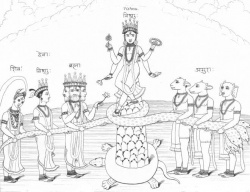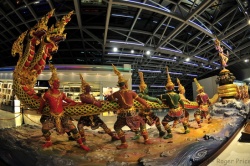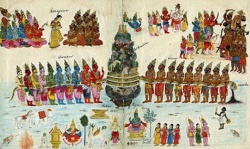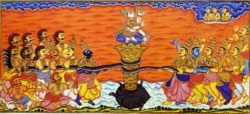Difference between revisions of "Amrita"
m (Text replacement - "sun" to "{{Wiki|sun}}") |
m (Text replacement - "Vajrayana Buddhism" to "Vajrayana Buddhism") |
||
| Line 32: | Line 32: | ||
Buddhism | Buddhism | ||
[[File:Sagar_mathan.jpg|thumb|250px|]] | [[File:Sagar_mathan.jpg|thumb|250px|]] | ||
| − | Amrit (Tibetan: bDud.rTsi, pronounced "dutsi"), also plays a significant role in [[Vajrayana | + | Amrit (Tibetan: bDud.rTsi, pronounced "dutsi"), also plays a significant role in [[Vajrayana Buddhism]] as a sacramental drink which is consumed at the beginning of all important [[rituals]] (e.g. abhisheka, ganachakra, Homa). In the Tibetan tradition, 'dutsi' is made during drubchens - lengthy ceremonies involving many high lamas. It usually takes the form of small, dark-brown grains that are taken with water, or dissolved in very weak solutions of alcohol, and is said to improve physical and spiritual well-being. |
A [[Vajrayana]] text called Dri.Med. Zhal.Ph'reng ("the immaculate crystal garland") describes the origin of [[amrita]] in a version of the Hindu "ocean-churning" legend re-told in [[Buddhist]] terms. In this [[Vajrayana]] version, the monster [[Rahu]] steals the [[amrita]] and is blasted by [[Vajrapani]]'s [[thunderbolt]]. As [[Rahu]] has already drunk the [[amrita]] he cannot die but his blood, dripping onto the surface of this earth, causes all kinds of medicinal plants to grow. At the behest of all the [[Buddhas]], [[Vajrapani]] reassembles [[Rahu]] who eventually becomes a protector of [[Buddhism]] (according to the [[Tibetan]] "[[Nyingma]]" tradition). | A [[Vajrayana]] text called Dri.Med. Zhal.Ph'reng ("the immaculate crystal garland") describes the origin of [[amrita]] in a version of the Hindu "ocean-churning" legend re-told in [[Buddhist]] terms. In this [[Vajrayana]] version, the monster [[Rahu]] steals the [[amrita]] and is blasted by [[Vajrapani]]'s [[thunderbolt]]. As [[Rahu]] has already drunk the [[amrita]] he cannot die but his blood, dripping onto the surface of this earth, causes all kinds of medicinal plants to grow. At the behest of all the [[Buddhas]], [[Vajrapani]] reassembles [[Rahu]] who eventually becomes a protector of [[Buddhism]] (according to the [[Tibetan]] "[[Nyingma]]" tradition). | ||
Revision as of 20:11, 12 September 2013
amrita
[甘露] (Skt; Pali amata; Jpn kanro )
A legendary, ambrosia-like liquid. In ancient India, it was regarded as the sweet-tasting beverage of the gods. In China, it was thought to rain down from heaven when the world became peaceful. Amrita is said to remove sufferings and give immortality. The word amrita means immortality and is often translated as sweet dew.
Amrita (Sanskrit: अमृत; IAST: amṛta) is a Sanskrit word that literally means "immortality", and is often referred to in texts as nectar. The word's earliest occurrence is in the Rigveda, where it is one of several synonyms of "soma" as the drink which confers immortality upon the gods. It is related etymologically to the Greek "ambrosia", and it carries the same meaning. It has various significances in different dharmic traditions. "Amrita" is also a common Hindu first name for men; the feminine is "Amritā".
Amrita (bdud rtsi). Same as 'Nectar Quality,' the heruka of the ratna family among the Eight Sadhana Teachings and the tantric teachings connected with that deity.
Hinduism
Amrita is repeatedly referred to as the drink of the gods, which grants them immortality.
Amrita features in the "ocean-churning" Samudra manthan legend, which describes how the devas, because of a curse from the sage Durvasa, begin to lose their immortality. Assisted by their mortal enemies, the asuras, they churn the ocean and create (among other wonderful things) amrita, the nectar of immortality.
In yogic philosophy (see yoga, Hindu philosophy) amrita is a fluid that can flow from the pituitary gland down the throat in deep states of meditation. It is considered quite a boon: some yogic texts say that one drop is enough to conquer death and achieve immortality.
Amrita is sometimes said to miraculously form on, or flow from, statues of Hindu gods. The substance so formed is consumed by worshippers and is alleged to be sweet-tasting and not at all similar to honey or sugar water.
Amrita (Devanagari - अमृत), are fourteen treasure jewels (Ratnas) that emerged from Samudra manthan ocean. The fourth Ratna which emerged is known as Kaustubha, the divine jewel of Vishnu.
Sikhism
Amrit (Punjabi: ਅੰਮ੍ਰਿਤ) is the name of the holy water used in the baptism ceremony (known as Amrit Sanskar or Amrit Chakhna by the Sikhs). This ceremony is observed to initiate the Sikhs into the Khalsa brotherhood. The ceremony requires the drinking of the Amrit. This water is created by mixing a number of soluble ingredients, including sugar, and is then rolled with a khanda (a double edged straight sword) with the accompaniment of scriptural recitation of five sacred Banis (chants). This Amrit is also referred to God's name as a nectar which is obtained through Guru's word, as in the following example of page 119 of Sri Guru Granth Sahib. Chanting God's name during Amrit Sanskar or Amrit Chakna uplifts a persons' physical and spiritual consciousness to a state of immortality.
ਅੰਮ੍ਰਿਤ ਸਬਦੁ ਅੰਮ੍ਰਿਤ ਹਰਿ ਬਾਣੀ ॥ अम्रित सबदु अम्रित हरि बाणी ॥ Amriṯ sabaḏ amriṯ har baṇī. The Shabd is Amrit; the Lord's Bani is Amrit.
ਸਤਿਗੁਰਿ ਸੇਵਿਐ ਰਿਦੈ ਸਮਾਣੀ ॥ सतिगुरि सेविऐ रिदै समाणी ॥ Saṯgur sevi▫ai riḏai samāṇī. Serving the True Guru, it permeates the heart.
ਨਾਨਕ ਅੰਮ੍ਰਿਤ ਨਾਮੁ ਸਦਾ ਸੁਖਦਾਤਾ ਪੀ ਅੰਮ੍ਰਿਤੁ ਸਭ ਭੁਖ ਲਹਿ ਜਾਵਣਿਆ ॥੮॥੧੫॥੧੬॥ नानक अम्रित नामु सदा सुखदाता पी अम्रितु सभ भुख लहि जावणिआ ॥८॥१५॥१६॥ Nānak amriṯ nām saḏā sukẖ▫ḏāṯa pī amriṯ sabẖ bẖukẖ lėh jāvaṇi▫ā. ||8||15||16|| O Nanak, the Ambrosial Naam is forever the Giver of peace; drinking in this Amrit, all hunger is satisfied. ||8||15||16||
Buddhism
Amrit (Tibetan: bDud.rTsi, pronounced "dutsi"), also plays a significant role in Vajrayana Buddhism as a sacramental drink which is consumed at the beginning of all important rituals (e.g. abhisheka, ganachakra, Homa). In the Tibetan tradition, 'dutsi' is made during drubchens - lengthy ceremonies involving many high lamas. It usually takes the form of small, dark-brown grains that are taken with water, or dissolved in very weak solutions of alcohol, and is said to improve physical and spiritual well-being.
A Vajrayana text called Dri.Med. Zhal.Ph'reng ("the immaculate crystal garland") describes the origin of amrita in a version of the Hindu "ocean-churning" legend re-told in Buddhist terms. In this Vajrayana version, the monster Rahu steals the amrita and is blasted by Vajrapani's thunderbolt. As Rahu has already drunk the amrita he cannot die but his blood, dripping onto the surface of this earth, causes all kinds of medicinal plants to grow. At the behest of all the Buddhas, Vajrapani reassembles Rahu who eventually becomes a protector of Buddhism (according to the Tibetan "Nyingma" tradition).
Chinese Buddhism describes Amrita (Chinese: 甘露 gān lù) as blessed water, food, or other consumable objects often produced through merits of chanting mantras.
In the most ancient times, the gods were engaged in constant warfare with their eternal adversaries: the asuras, the daityas and the danavas, and on one occasion the gods had been soundly defeated by the danavas.1 They were extremely dejected and appealed to the wise god Viṣnu for his advice. He counseled them to unite with their enemies and make peace by collaborating with the danavas on a joint project. The ocean, he pointed out, contained several fabulous treasures which would be revealed if it were churned, a feat which the gods, working alone, could never accomplish.
First they scattered various herbs in the ocean and then, taking Mt. Mandara as their churning-stick, they turned it upside-down and balanced it on the back of a giant turtle who was resting on the seabed (actually this was Viṣnu in one of his many disguises). As a churning-rope, they used the serpent-king Vāsuki,2 winding him three and a half times around the mountain.3 The gods and danavas took opposite ends of the great serpent and hauled him back and forth, causing the mountain to spin this way and that on its turtle-pivot. They kept up this to-and-fro motion for over a thousand years and, just as butter emerges from milk, many wonderful treasures floated to the surface of the ocean.
Though there were several other wonders, the greatest of all was amṛita. All three versions of the story tell of a noxious by-product, a virulent poison called kalakhuta (“mass of blackness”), hālāhala or simply viśa (“poison”).4 In some accounts, this is simply the final product to emerge from the ocean. Others say that Vasuki, unaccustomed to being used as the rope in a cosmic tug-of-war, vomited up the kalakhuta. This latter explanation presumes that nāgā-vomit, like snake venom, is virulently toxic.
Whatever the origin of the kalakhuta/hālāhala, Śiva saved the world from its perils by drinking it himself. Due to the extreme toxicity of the kalakhuta/hālāhala even Śiva dare not swallow it all the way. Instead, by yogic control and unwavering attention he holds the poison safely in his throat. The constant presence of this poison has caused his throat to change color and this, we are told, explains Śiva’s blue throat.
The original agreement had been that the asuras, daityas and danavas would share the amṛita with the gods but at the last moment the gods changed their minds. Viṣnu took the form of a beautiful woman known as “the enchantress” (Skt., mohinī) and distracted the asuras while the gods took all the amṛita.
One of the asuras, Rāhu by name, managed to get in line with the gods as the amṛita was being doled out and drank his share before being discovered. As soon as Rāhu was found out, Viṣnu hurled his magic discus (Skt., cakra) and decapitated him. But Rāhu had already drunk amṛita, the drink which confers immortality, so both his head and body continue to live. It is Rāhu’s head which causes eclipses as he tries to eat the sun and moon. In astronomical terms, Rāhu represents the “ascending node” of the moon. That is, he is one of two points at which the orbit of the moon crosses the plane of the ecliptic, the other being the moon’s “descending node”. Known in Sanskrit as Ketu, this is said to be Rāhu’s body.



